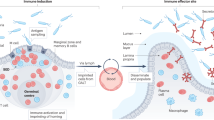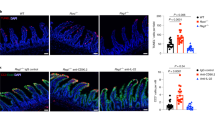Abstract
The largest mucosal surface in the body is in the gastrointestinal tract, a location that is heavily colonized by microbes that are normally harmless. A key mechanism required for maintaining a homeostatic balance between this microbial burden and the lymphocytes that densely populate the gastrointestinal tract is the production and transepithelial transport of poly-reactive IgA (ref. 1). Within the mucosal tissues, B cells respond to cytokines, sometimes in the absence of T-cell help, undergo class switch recombination of their immunoglobulin receptor to IgA, and differentiate to become plasma cells2. However, IgA-secreting plasma cells probably have additional attributes that are needed for coping with the tremendous bacterial load in the gastrointestinal tract. Here we report that mouse IgA+ plasma cells also produce the antimicrobial mediators tumour-necrosis factor-α (TNF-α) and inducible nitric oxide synthase (iNOS), and express many molecules that are commonly associated with monocyte/granulocytic cell types. The development of iNOS-producing IgA+ plasma cells can be recapitulated in vitro in the presence of gut stroma, and the acquisition of this multifunctional phenotype in vivo and in vitro relies on microbial co-stimulation. Deletion of TNF-α and iNOS in B-lineage cells resulted in a reduction in IgA production, altered diversification of the gut microbiota and poor clearance of a gut-tropic pathogen. These findings reveal a novel adaptation to maintaining homeostasis in the gut, and extend the repertoire of protective responses exhibited by some B-lineage cells.
This is a preview of subscription content, access via your institution
Access options
Subscribe to this journal
Receive 51 print issues and online access
$199.00 per year
only $3.90 per issue
Buy this article
- Purchase on Springer Link
- Instant access to full article PDF
Prices may be subject to local taxes which are calculated during checkout




Similar content being viewed by others
References
Hooper, L. V. & Macpherson, A. J. Immune adaptations that maintain homeostasis with the intestinal microbiota. Nature Rev. Immunol. 10, 159–169 (2010)
Fagarasan, S., Kawamoto, S., Kanagawa, O. & Suzuki, K. Adaptive immune regulation in the gut: T cell-dependent and T cell-independent IgA synthesis. Annu. Rev. Immunol. 28, 243–273 (2010)
Lee, M. R., Seo, G. Y., Kim, Y. M. & Kim, P. H. iNOS potentiates mouse Ig isotype switching through AID expression. Biochem. Biophys. Res. Commun. 410, 602–607 (2011)
Tezuka, H. et al. Regulation of IgA production by naturally occurring TNF/iNOS-producing dendritic cells. Nature 448, 929–933 (2007)
Kang, H. S. et al. Signaling via LTβR on the lamina propria stromal cells of the gut is required for IgA production. Nature Immunol. 3, 576–582 (2002)
Serbina, N. V., Salazar-Mather, T. P., Biron, C. A., Kuziel, W. A. & Pamer, E. G. TNF/iNOS-producing dendritic cells mediate innate immune defense against bacterial infection. Immunity 19, 59–70 (2003)
Muramatsu, M. et al. Class switch recombination and hypermutation require activation-induced cytidine deaminase (AID), a potential RNA editing enzyme. Cell 102, 553–563 (2000)
Crouch, E. E. et al. Regulation of AID expression in the immune response. J. Exp. Med. 204, 1145–1156 (2007)
Serbina, N. V. & Pamer, E. G. Monocyte emigration from bone marrow during bacterial infection requires signals mediated by chemokine receptor CCR2. Nature Immunol. 7, 311–317 (2006)
Hapfelmeier, S. et al. Reversible microbial colonization of germ-free mice reveals the dynamics of IgA immune responses. Science 328, 1705–1709 (2010)
Cumano, A., Dorshkind, K., Gillis, S. & Paige, C. J. The influence of S17 stromal cells and interleukin 7 on B cell development. Eur. J. Immunol. 20, 2183–2189 (1990)
Tumanov, A. V. et al. Cellular source and molecular form of TNF specify its distinct functions in organization of secondary lymphoid organs. Blood 116, 3456–3464 (2010)
Ivanov, I. I. & Littman, D. R. Modulation of immune homeostasis by commensal bacteria. Curr. Opin. Microbiol. 14, 106–114 (2011)
Suzuki, K. et al. Aberrant expansion of segmented filamentous bacteria in IgA-deficient gut. Proc. Natl Acad. Sci. USA 101, 1981–1986 (2004)
Maaser, C. et al. Clearance of Citrobacter rodentium requires B cells but not secretory immunoglobulin A (IgA) or IgM antibodies. Infect. Immun. 72, 3315–3324 (2004)
Delogu, A. et al. Gene repression by Pax5 in B cells is essential for blood cell homeostasis and is reversed in plasma cells. Immunity 24, 269–281 (2006)
Li, J. et al. B lymphocytes from early vertebrates have potent phagocytic and microbicidal abilities. Nature Immunol. 7, 1116–1124 (2006)
Johnson, B. A. et al. B-lymphoid cells with attributes of dendritic cells regulate T cells via indoleamine 2,3-dioxygenase. Proc. Natl Acad. Sci. USA 107, 10644–10648 (2010)
Kelly-Scumpia, K. M. et al. B cells enhance early innate immune responses during bacterial sepsis. J. Exp. Med. 208, 1673–1682 (2011)
Neves, P. et al. Signaling via the MyD88 adaptor protein in B cells suppresses protective immunity during Salmonella typhimurium infection. Immunity 33, 777–790 (2010)
Cumano, A., Paige, C. J., Iscove, N. N. & Brady, G. Bipotential precursors of B cells and macrophages in murine fetal liver. Nature 356, 612–615 (1992)
Montecino-Rodriguez, E., Leathers, H. & Dorshkind, K. Bipotential B-macrophage progenitors are present in adult bone marrow. Nature Immunol. 2, 83–88 (2001)
Pelletier, N. et al. Plasma cells negatively regulate the follicular helper T cell program. Nature Immunol. 11, 1110–1118 (2010)
Peterson, D. A., McNulty, N. P., Guruge, J. L. & Gordon, J. I. IgA response to symbiotic bacteria as a mediator of gut homeostasis. Cell Host Microbe 2, 328–339 (2007)
Marshall, A. J., Paige, C. J. & Wu, G. E. V. (H) repertoire maturation during B cell development in vitro: differential selection of Ig heavy chains by fetal and adult B cell progenitors. J. Immunol. 158, 4282–4291 (1997)
Barman, M. et al. Enteric salmonellosis disrupts the microbial ecology of the murine gastrointestinal tract. Infect. Immun. 76, 907–915 (2008)
Petnicki-Ocwieja, T. et al. Nod2 is required for the regulation of commensal microbiota in the intestine. Proc. Natl Acad. Sci. USA 106, 15813–15818 (2009)
Furet, J. P. et al. Comparative assessment of human and farm animal faecal microbiota using real-time quantitative PCR. FEMS Microbiol. Ecol. 68, 351–362 (2009)
Milne, C. D., Fleming, H. E. & Paige, C. J. IL-7 does not prevent pro-B/pre-B cell maturation to the immature/sIgM+ stage. Eur. J. Immunol. 34, 2647–2655 (2004)
Acknowledgements
We thank D. White in the Faculty of Medicine Flow Cytometry core facility and H. Singh for critical reading of the manuscript. We thank E. Verdu for providing additional germ-free mice at short notice, and we also thank C. Guidos for numerous Rag2−/− mice for mixed bone marrow chimeras. C.J.P. is supported by a CIHR operating grant MOP number 9862. R.C. is supported in part by the Intramural Research Program of the National Institute of Arthritis and Musculoskeletal and Skin Diseases of the National Institutes of Health. I.I.I. is supported by NIH (R00 DK085329-02) and CCFA (CDA #2388). A.M. is supported by a CIHR operating grant MOP number 89783. J.H.F. acknowledges support by an APART-fellowship of the Austrian Academy of Sciences, McGill start-up funds and a CIHR operating grant MOP number 114972. N.S. acknowledges the support of a CIHR Doctoral Award. J.L.G. is funded by the Canadian Institutes of Health Research (CIHR) and acknowledges the support of CIHR operating grant MOP number 67157 as well as infrastructure support from the Ontario Research Fund and that Canadian Foundation for Innovation. All authors have reviewed and agree with the content of the manuscript.
Author information
Authors and Affiliations
Contributions
J.H.F. generated data in Figs 1d–f, 3a–d, 4d–f and Supplementary Figs 2–4, 7 and 8. O.L.R. contributed data in Figs 1a–d, 3a, b, 4, Supplementary Figs 7, 8 and Supplementary Tables 1–3. N.S. and C.J.P. contributed data in Fig. 2b and Supplementary Fig. 6. D.D.M. contributed data in Figs 1a, b, 2a and Supplementary Figs 1–3. S.H. contributed data in Fig. 2a. A.M. and M.L. contributed Supplementary Fig. 1b (D.M. did the sort). R.C. provided AID–YFP mice. I.I.I. originally suggested that we examine IgA+ plasma cells as putative TNF-α/iNOS-producing cells and urged us to do the initial experiments. D.J.P and S.J.R. contributed data in Fig. 3e and provided critical insights. S.E.G. and S.R. helped us set up the Citrobacter rodentium experiments and provided critical insights. A.J.M., S.H. and K.D.M. provided intestinal tissues from germ-free and re-colonized mice. J.G. provided gene-deficient mice. J.L.G. wrote the manuscript and obtained funding for the work from the Canadian Institutes of Health Research.
Corresponding author
Ethics declarations
Competing interests
The authors declare no competing financial interests.
Supplementary information
Supplementary Information
This file contains Supplementary Figures 1-8, Supplementary Tables 1-4 and an additional reference. (PDF 3061 kb)
Rights and permissions
About this article
Cite this article
Fritz, J., Rojas, O., Simard, N. et al. Acquisition of a multifunctional IgA+ plasma cell phenotype in the gut. Nature 481, 199–203 (2012). https://doi.org/10.1038/nature10698
Received:
Accepted:
Published:
Issue Date:
DOI: https://doi.org/10.1038/nature10698
This article is cited by
-
TCDD exposure alters fecal IgA concentrations in male and female mice
BMC Pharmacology and Toxicology (2022)
-
Coordinated co-migration of CCR10+ antibody-producing B cells with helper T cells for colonic homeostatic regulation
Mucosal Immunology (2021)
-
B cell depletion therapies in autoimmune disease: advances and mechanistic insights
Nature Reviews Drug Discovery (2021)
-
Rethinking mucosal antibody responses: IgM, IgG and IgD join IgA
Nature Reviews Immunology (2020)
-
Microbiota therapy acts via a regulatory T cell MyD88/RORγt pathway to suppress food allergy
Nature Medicine (2019)
Comments
By submitting a comment you agree to abide by our Terms and Community Guidelines. If you find something abusive or that does not comply with our terms or guidelines please flag it as inappropriate.



